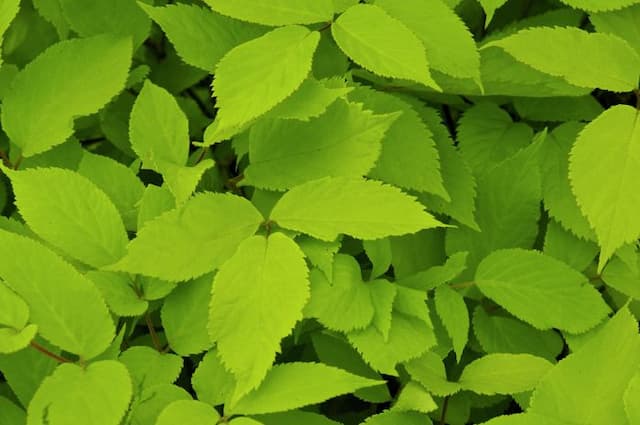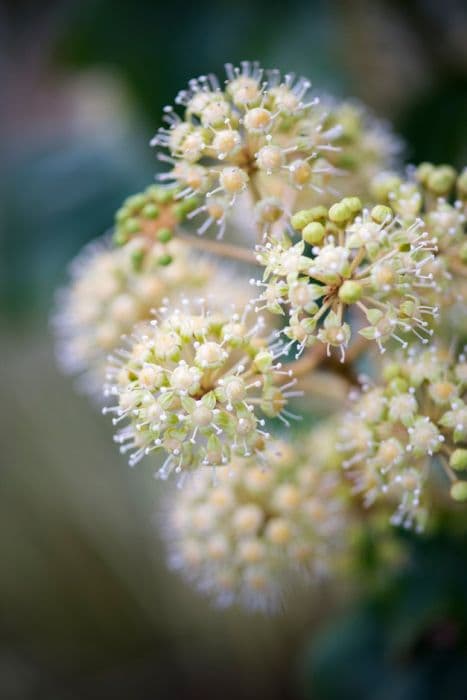Japanese aralia Fatsia japonica 'Tsumugi-shibori' (v)

ABOUT
Fatsia japonica 'Tsumugi-shibori', commonly known as the Japanese aralia, is a visually striking plant characterized by its bold and distinctive foliage. The leaves are glossy, deeply lobed, and have a hand-like appearance with finger-like projections, which can give them an almost tropical look. This variety is particularly noted for its variegated leaves, which feature a patchwork of green alongside creamy white and yellowish blotches, creating a marbled or speckled effect. The variegation can vary greatly from leaf to leaf, sometimes with more white and other times with more green, contributing to the plant's intriguing and variable appearance. During certain times of the year, the Japanese aralia may produce spherical flower clusters, which are followed by small, non-edible black fruit. The contrast between the foliage and these subtle flowers and fruits can add an extra layer of interest to the plant's overall appearance. While mature plants can become quite substantial in presence, this description specifically omits any dimensions related to the size of Japanese aralia, focusing instead on its aesthetic qualities. The leaf structure and variegation patterns remain the key elements that define the appearance of Fatsia japonica 'Tsumugi-shibori'.
About this plant
 Names
NamesFamily
Araliaceae
Synonyms
Japanese Aralia, Glossy-leaf Paper Plant, Fatsi, Fig-leaf Palm, Spiders Web
Common names
Fatsia japonica 'Tsumugi-shibori'
 Toxicity
ToxicityTo humans
The Japanese aralia is not considered highly toxic to humans, but it can cause irritation if ingested. The symptoms of poisoning are generally mild and can include a burning sensation in the mouth, lips, and throat, as well as possible nausea and vomiting. In rare cases, handling the plant might cause skin irritation or an allergic reaction.
To pets
The Japanese aralia is considered to be mildly toxic to pets. If ingested by cats or dogs, it can cause gastrointestinal upset which may include vomiting, diarrhea, and drooling. Pets may also experience mild mouth irritation if they chew on the plant. It's advisable to keep this plant out of reach of your pets to prevent any discomfort or health issues.
 Characteristics
CharacteristicsLife cycle
Perennials
Foliage type
Evergreen
Color of leaves
Variegated
Flower color
White
Height
6-10 feet (1.8-3 meters)
Spread
6-10 feet (1.8-3 meters)
Plant type
Shrub
Hardiness zones
8
Native area
Japan
Benefits
 General Benefits
General Benefits- Ornamental Appeal: The Fatsia japonica 'Tsumugi-shibori', also known as the Japanese aralia, boasts variegated leaves that add visual interest and ornamental value to gardens and indoor spaces.
- Shade Tolerance: This plant is well-suited for shaded areas in the garden where other plants may struggle to flourish.
- Low Maintenance: Japanese aralia typically requires minimal care, making it an easy choice for gardeners of all skill levels.
- Drought Resistance: Once established, it can tolerate periods of drought, reducing the need for frequent watering.
- Cold Hardiness: It can handle cooler temperatures, making it a suitable choice for a range of climates.
- Privacy Screen: With its dense foliage, the Japanese aralia can be used as a natural privacy screen in gardens or landscapes.
- Pest Resistant: Generally resilient to pests, which means less need for chemical treatments.
- Adaptable: It can adapt to a variety of soil types as long as they are well-draining.
- Evergreen: As an evergreen plant, the Japanese aralia provides year-round greenery and structure in the garden.
- Wildlife Support: The plant can offer shelter to birds and insects, contributing to biodiversity.
 Medical Properties
Medical PropertiesThis plant is not used for medical purposes.
 Air-purifying Qualities
Air-purifying QualitiesThis plant is not specifically known for air purifying qualities.
 Other Uses
Other Uses- Fatsia japonica 'Tsumugi-shibori' can be used in bonsai cultivation due to its visually appealing foliage and the ability to adapt to pruning and shaping.
- The broad leaves of the Fatsia can be used as natural wrappers for small packages or to wrap mochi and other traditional Japanese sweets.
- Its distinctive marbled leaves can serve as an artistic inspiration for designers and can be seen reflected in patterns for textiles and wallpaper.
- As a prop in photography and theater, the Fatsia's dramatic foliage can create dense, tropical backdrops or conceal unwanted items in a scene.
- It can play a role in educational settings, where horticulture students can study its growth patterns and propagation methods.
- Fatsia leaves can be used to create leaf mold compost, providing a nutrient-rich soil amendment for gardeners.
- The resilience and dense growth of the Fatsia make it a good candidate for creating green mazes or garden labyrinths in landscape design.
- The plant can also serve as a living sculpture in decorative arts, being trained into various forms for visual interest.
- During festive seasons, the glossy leaves can be used to create natural holiday wreaths and other decorations.
- The plant's structure and volume make it a suitable habitat for garden wildlife, such as certain bird species that nest in dense shrubbery.
Interesting Facts
 Feng Shui
Feng ShuiThe Paper Plant is not used in Feng Shui practice.
 Zodiac Sign Compitability
Zodiac Sign CompitabilityThe Paper Plant is not used in astrology practice.
 Plant Symbolism
Plant Symbolism- Growth and Vitality: The Fatsia japonica, commonly known as the Japanese aralia, is a lush, leafy plant that symbolizes personal growth and vitality due to its vigorous growth habit and resilience in various environments.
- Protection: In some cultures, the dense foliage of the Japanese aralia is believed to represent protection and shelter, offering a sense of safety and refuge.
- Diversity and Uniqueness: The 'Tsumugi-shibori' variety, with its variegated leaves, can be seen as a symbol of diversity and celebrating unique characteristics, as no two leaves have exactly the same pattern.
- Good Fortune: Some people might view the Japanese aralia as a good luck charm, believing that the plant can bring prosperity and wealth into a home or business.
- Purity: Spirits and entities in Japanese folklore are often associated with plants, and an evergreen plant like the Japanese aralia is sometimes thought to embody purity and the enduring nature of life.
 Water
WaterThe Paper Plant should be watered when the top inch of soil feels dry to the touch, which typically equates to watering once a week. However, frequency can vary based on factors such as temperature, humidity, and light conditions. When watering, do so thoroughly, allowing water to run through the drainage holes at the bottom of the pot, which might require around 16 to 32 ounces of water depending on the size of the plant and the pot. Be cautious not to overwater, as standing water can lead to root rot. During winter months, when plant growth slows down, reduce watering to every other week or as needed.
 Light
LightThe Paper Plant thrives in bright, indirect light but can also tolerate partial shade. It should not be placed in direct sunlight, as this can scorch its leaves. The best spot for this plant would be near a north or east-facing window, where it can receive gentle morning light or filtered afternoon light. If natural light is limited, supplement with artificial grow lights to maintain its health.
 Temperature
TemperatureThe Paper Plant prefers normal room temperatures between 60°F and 75°F. It can tolerate a minimum of 50°F but should be protected from cold drafts and sudden temperature changes. Ideal conditions would involve maintaining a consistent temperature within its preferred range to ensure optimal growth and health.
 Pruning
PruningPrune the Paper Plant to maintain its shape, remove any dead or yellowing leaves, and encourage fuller growth. The best time for pruning is in the spring before new growth begins. Pruning can be done once or twice a year as needed, using clean and sharp shears to make precise cuts without damaging the remaining foliage.
 Cleaning
CleaningAs needed
 Soil
SoilThe Japanese Aralia 'Tsumugi-shibori' thrives in a well-draining, peat-based potting mix with added perlite or bark to ensure good aeration. The ideal pH for this plant is slightly acidic to neutral, ranging from 6.0 to 7.5. Regular potting soil improved with compost and additional drainage elements like sand or perlite creates the perfect environment for healthy root development.
 Repotting
RepottingJapanese Aralia 'Tsumugi-shibori' should generally be repotted every two to three years or when it outgrows its current pot. Choose a container only slightly larger than the previous one to avoid overpotting, which can lead to water retention issues.
 Humidity & Misting
Humidity & MistingJapanese Aralia 'Tsumugi-shibori' enjoys high humidity levels, ideally between 60% and 75%. To maintain these conditions, mist regularly, use a pebble tray with water, or employ a humidifier in drier climates or indoor environments to keep the plant healthy and vibrant.
 Suitable locations
Suitable locationsIndoor
Place in bright, indirect light and maintain high humidity.
Outdoor
Provide partial shade, shelter from intense sun and wind.
Hardiness zone
7-10 USDA
 Life cycle
Life cycleFatsia japonica 'Tsumugi-shibori', commonly known as variegated Japanese aralia, begins its life as a seed, typically germinating in moist, well-drained soil in partial shade. Once germinated, the seedling stage involves the establishment of a small rosette of leaves and a root system. As it enters the juvenile phase, the plant develops its characteristic large, palmate, variegated leaves and begins to form a woody stem, growing steadily into a bushy shrub. During its adult phase, the Japanese aralia can produce clusters of small, white flowers in the fall, followed by black, inedible berries if pollination occurs. The plant reaches maturity and maintains itself through vegetative growth, replacing older leaves with new growth and occasionally branching out to increase its size. As a perennial, Fatsia japonica 'Tsumugi-shibori' may live for many years, with a life cycle heavily dependent on proper care and environmental conditions.
 Propogation
PropogationPropogation time
Spring-Early Summer
The most popular method of propagating Paperplant 'Tsumugi-shibori' is via semi-hardwood cuttings. This process is best done in late summer. Cuttings should be around 4 to 6 inches (10 to 15 cm) long and include several leaf nodes. Leaves at the lower end of the cutting should be removed, and the base dipped in rooting hormone to encourage root development. The cutting is then planted in a mixture of peat and perlite or a similar well-draining potting mix. It should be kept humid by covering the pot with a plastic bag or placing it in a propagator, and placed in indirect light until roots have formed, after which it can be potted up separately.









